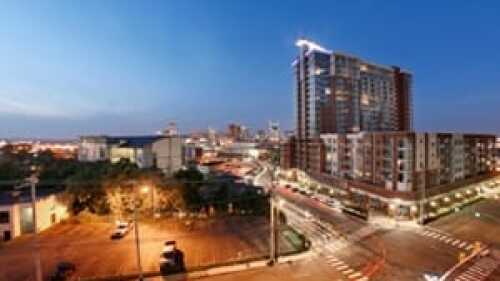Public Spaces
Thirty years of European infrastructure investments and education have produced a different pattern of urban transportation—one that could influence decisions in the United States. Read what largely neglected form of transportation could help U.S. cities reduce commuter trips by car in urban centers.
When Underhill Associates was converting an apartment complex into condominiums in the early 2000s, the firm’s partners saw the Camelot Shopping Center across the street continue its decline. Read how, with a focus on locally owned businesses, the Louisville, Kentucky, developer was able to turn the aging retail center into Westport Village, a pedestrian-friendly lifestyle center.
Described as “the heart of Detroit’s development story,” Campus Martius, a 2.5-acre (1-ha) public park that opened in November 2004, has become an economic engine for Motown, spurring two major office buildings adjacent to the park as well as residential developments and restaurants nearby. Learn who and what made this project the first-ever recipient of the ULI Amanda Burden Open Space Award.
Employing an approach that includes new development and adaptive use, and that leverages its solid economic base and strong job growth, Nashville, Tennessee, is seeing successful redevelopment of both its urban core and waterfront. Read how projects ranging from for-rent workforce housing to mixed-use development to a convention center are poised to drive continued economic development in Music City.
Leaders who worked on three transformative urban projects showed why the projects had distinguished themselves as ULI award winners at the “Game Changers” session at ULI’s 2010 Fall Meeting. Urban Redevelopment Authority of Singapore introduced The Southern Ridges; Downtown Fort Worth, Texas and its Sundance Square; and, Columbia Heights, a historic neighborhood in northwest Washington, D.C., and its commercial center are three case studies that offer what the public sector can do, even in the current economic climate.
A debate is taking place right now on how best to protect and preserve one of America’s national treasures, the National Mall, and ensure that it remains what Pierre L’Enfant first imagined it to be—an open space featuring statues and memorials to honor worthy citizens. Should we revisit the 1901 McMillan Plan or begin anew?
Given the economic downturn and the scarcity of capital, public/private partnerships may seem appealing to more real estate developers than ever. Yet navigating the intricacies of these ventures can involve a steep learning curve. Three members of ULI’s Public/Private Partnership Council (Gold Flight) offer insights based on their extensive experience.
A land-based approach to solving America’s economic crisis would enable municipalities to acquire vacant properties to develop into parks and green space.






